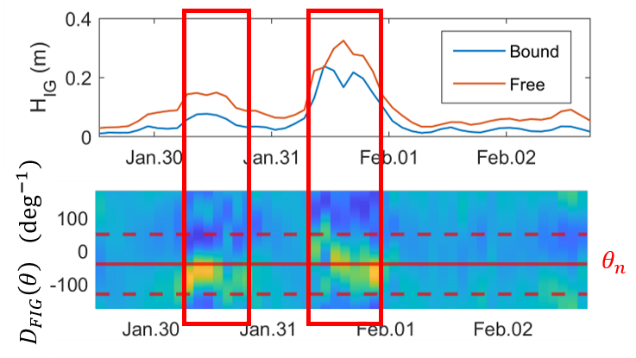J. Rutten*1, X. Zhang, A. Reniers1, P. Van Wiechen1, S. de Vries1 , D. Rijnsdorp1, M. Tissier1
1 Delft University of Technology
*corresponding author:
Introduction
Infragravity waves (IG) are long period (25s-250s) waves that contribute importantly to extreme runup and hence are a driver for dune erosion. The description of IG waves at the offshore boundary is important to predict accurately the coastal impact and safety. However, uncertainties exist. Generally, bound IG waves (BIG), proportional to sea-swell (SS) wave energy, are included but free IG waves (FIG) are not. In semi-enclosed basins, such as the North Sea, FIG energy can be substantial (e.g., Reniers et al., 2021; Rijnsdorp et al., 2021). Numerical modelling (Rijnsdorp et al., 2021) demonstrated that FIG waves may bounce off the distant coasts of the UK and Denmark, cross the North Sea basin, and become a source of incoming IG energy at the Dutch coast. To further improve the understanding and quantify the importance of incoming FIG waves in semi-enclosed basins, observations of the directional field of BIG and FIG waves are essential. In this contribution, we aim to determine the directional characteristics of bound and free IG waves from detailed measurements of an entire storm season (2021/2022).
Methods
A 5-month dataset (Nov 2021-Apr 2022) of continuous 4 Hz measurements of velocity, pressure and sea surface elevation was collected as part of the Realdune/REFLEX campaign. Data was obtained by ADCPs and an ADV deployed in a cross-shore array with bottom frames at 14.5m, 8.9m and 6.5 m depth. BIG waveheight (HBIG) was estimated from the pressure head time series using bispectral analysis, whereas FIG waveheight (HFIG) followed from the total IG waveheight (HTIG) and HBIG. Directional spectra of BIG and FIG waves were estimated using the spectra reconstruction method of Matsuba et al. (2022).
Results
Ten energetic events were identified in the data set with substantial HTIG (> 0.12m at the most offshore frame). Figure 1 shows how BIG and FIG evolve during the most energetic event. The directional distribution of FIG changes from isotropic to anisotropic during the peaks of the storm (red boxes). At the conference we will discuss in detail how the direction of FIG waves changes from predominantly outgoing to incoming depending on the direction of SS waves. Potentially, the observed energetic incoming FIG waves are important to accurately assess coastal safety.

Figure 1: Evolution of bound and free infragravity waveheight (top) and the free infragravity directional distribution (bottom) during storm Corrie (2022). The horizontal line on the bottom panel represents the shorenormal θn, and the dashed lines θn +/- 90degrees.
References
Matsuba et al. (2022). Reconstruction of Directional Spectra of Infragravity Waves. JGR Oceans.
Reniers et al. (2021). North Sea Infragravity Wave Observations. J. Mar. Sci. Eng.
Rijnsdorp et al. (2021). Free infragravity waves in the North Sea. JGR Oceans.
I. Surname1*, F.N. Another-Surname2 , Y. Next-Surname2
1 University Name, Country; 2 Organization Name, Country
* Corresponding author: mail.name@organization.org


